610 Search Results for visual support
August 26, 2020
by Carole Zangari -
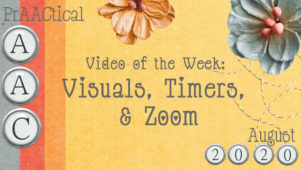
In many places, parents and professionals are struggling to help students acclimate to online learning. In today’s video, we feature a session hosted by the Indiana Resource Center for Autism. Check out the tips and suggestions that Leslie Brown provides to help learners be successful in online learning through the use of visual supports and timers. Click on the image below to view this video. Direct Link to Video – https://www.youtube.com/watch?v=hR8Odb6AgI0
August 3, 2020
by Carole Zangari -
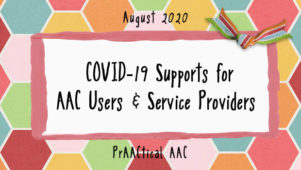
“I need to prepare my child for nasal swab testing.” “How can I get my students to wear their masks?” “My students don’t wash their hands properly.” “What vocabulary and messages should I add to SGDs for my students to be able to talk about the coronavirus?” “How can I explain social distancing in ways that make sense?” “What can I do to help my students know what to expect from a Zoom session?” If you have questions like these, take some time to browse through this online resource list with over 150 free downloads, videos, and more. We’ve updated this resource quite a bit since it was first published 4 months ago and are re-publishing it for those who need visual supports, social stories, videos, and communication boards. In the online newsletter below, you can access visual schedules for handwashing, social narratives, videos, educational materials, and more by clicking... [Read More...]
November 11, 2019
by Carole Zangari -

In many organizations, the AAC practices of individual therapists and teachers outpace the support for AAC by the larger staff or community. Here are some suggestions for building more wide-spread support for AAC in schools and other agencies. Take advantage of any requirements to attend mandatory training events. Most school districts have mandatory staff development days, and often, the training provided on those days has little or no relevance to those who do AAC work. Perhaps you can offer a more relevant alternative. Work with administrators to be able to provide AAC training on these days to share information on AAC implementation with teachers, paraprofessionals, and therapists. To get a spot on that calendar, it may take a while to establish rapport and relationships with the leadership team and various department heads but this is time and effort well-spent. Invite administrators, department heads, and committee chairs to AAC-related events on... [Read More...]
June 19, 2019
by Carole Zangari -
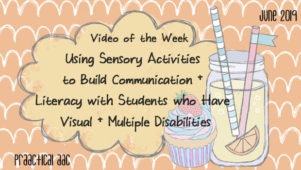
Teachers and therapists sometimes struggle to find effective ways to support students with multiple disabilities who have visual impairments. In today’s video, Faye Gonzalez, a teacher of the visually impaired, helps us understand ways that we can incorporate sensory activities to help these students further develop their communication, language and literacy skills. Many thanks to Faye and to Perkins for hosting this archived presentation. You can access the handout for this session here. The downloadable blank book template is available here. Direct Link to Video Page: https://www.perkinselearning.org/videos/webinar/sensory-activities-experiences-improve-communication-and-literacy-children-visual-and
March 11, 2019
by Carole Zangari -
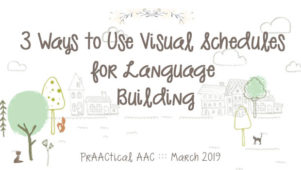
Visual schedules are powerful tools for supporting comprehension, reducing anxiety, and helping learners with AAC needs become more independent. They can also be used to build receptive and expressive language. To do that, though, the use of daily or mini/task schedules has to be part of an interactive experience, not an independent activity. If you’re willing to use schedules for language building, here are some ideas to consider incorporating. Sentence Building: This is an easy one. If you are working with an AAC learner who communicates primarily with one word/symbol at a time, slow down and take time to model short sentences every time you check the schedule together by adding a verb (e.g., GO to LifeSkills; EAT lunch, PUT AWAY your backpack). Once you’ve established that routine, you can pause to elicit those same sorts of sentences from the AAC learner. Verb Tense: As you use the schedule... [Read More...]
July 30, 2018
by Carole Zangari -
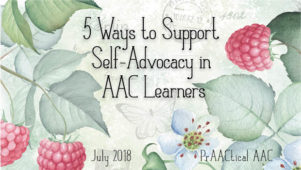
self-ad·vo·ca·cy: self ˈadvəkəsē/ Noun: the action of representing oneself or one’s views or interests. —————————- Empowering AAC learners to advocate for themselves may be one of the most important and impactful things that we can do to help them stay safe and achieve their goals. Here are some ways we can support that process. Provide messages for self-advocacy behaviors: It’s hard to represent your own interests without the appropriate set of vocabulary and messages. Words and prestored messages for protesting and rejecting are essential (e.g., No; Stop; No, thank you; I don’t want to). In addition, consider adding messages which allow the communicator to express disagreement or negative opinions (e.g., I don’t like it; I don’t think so; That doesn’t work for me; This is unfair; That’s disrespectful) and proactively provide self-advocacy information (e.g., Please do what I asked; It’s on my IEP; I have a right to be heard; I... [Read More...]
April 6, 2017
by Carole Zangari -
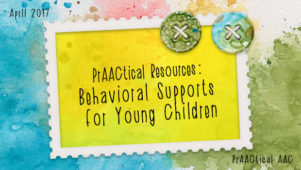
One of the biggest stressors for therapists and educators who work with AAC is dealing with challenging behavior. In today’s post, we share a wonderful set of resources on positive approaches to preventing, minimizing, and de-escalating instances of challenging behavior. The Technical Assistance Center of Social Emotional Intervention for Young Children produced a number of resources that are available on their website here. Topics include: Tips and forms for getting started Using a Buddy System Teacher tools Turtle Technique Visual supports Using scripts Circle time tips Dealing with feelings Strategies for families to use at home There is also a helpful Tool Kit that can be accessed via the image below.
March 30, 2017
by Carole Zangari -
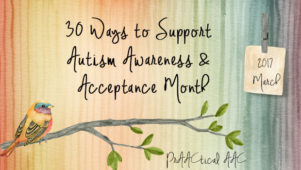
April is just around the corner and that means we’re getting ready to support the acceptance and inclusion of autistic people. Looking for ideas? Here are some to get you started. Treat yourself to some goodies from The Chocolate Spectrum (where you can order online, visit the cafe, or take a chocolate-making class) or other places that employ people with autism. Read and share 5 references that support the use of AAC & Autism. Help your family or community go beyond awareness and into acceptance. Learn and share information about Autism Safety – Be AWAARE! Know an autistic MineCraft lover? Introduce them to AutCraft. Educate yourself on terminology that relates to autism and people with ASD. We may have learned people-first language back in grad school, but there are different points of view on that. This is a great time to learn about identity-first language. Apply your critical reasoning skills to... [Read More...]
March 20, 2017
by Carole Zangari -
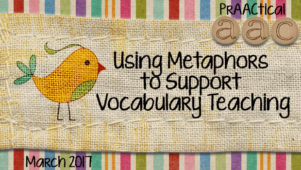
One of the really fun things about writing posts about vocabulary is that it gives us a great excuse to browse some teacher and SLP blogs. Sometimes their creativity blows me away, not to mention how incredibly engaging and cute they are! I especially love the creative themes that they use to go way beyond the ‘Vivid Verbs’ concept. Metaphors and visual imagery are both research-backed strategies for retaining new information. That’s important, especially as we move beyond core vocabulary and expose our AAC learners to a richer lexicon. Both can be used in a variety of games and activities and go a long way toward build engagement about new word learning. In the hands of an enthusiastic instructor, a metaphor can be developed into a theme that boosts the ‘fun factor,’ which is important when we’re trying to build the buzz around new word learning. Here are some of... [Read More...]
November 15, 2016
by Carole Zangari -
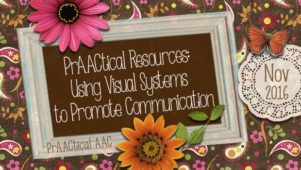
Looking for a handy guide to help families who are new to communication disability get familiar with visual supports for communication? In today’s post, we share a wonderful booklet intended just for that purpose. Australian SLP Dolly Bhargava created this book, Getting Started: Using Visual Systems to Promote Communication, with support from the School for Parents and the Non Government Centre Support for Non School Organisations of Western Australia. You can see the accompanying video here.









